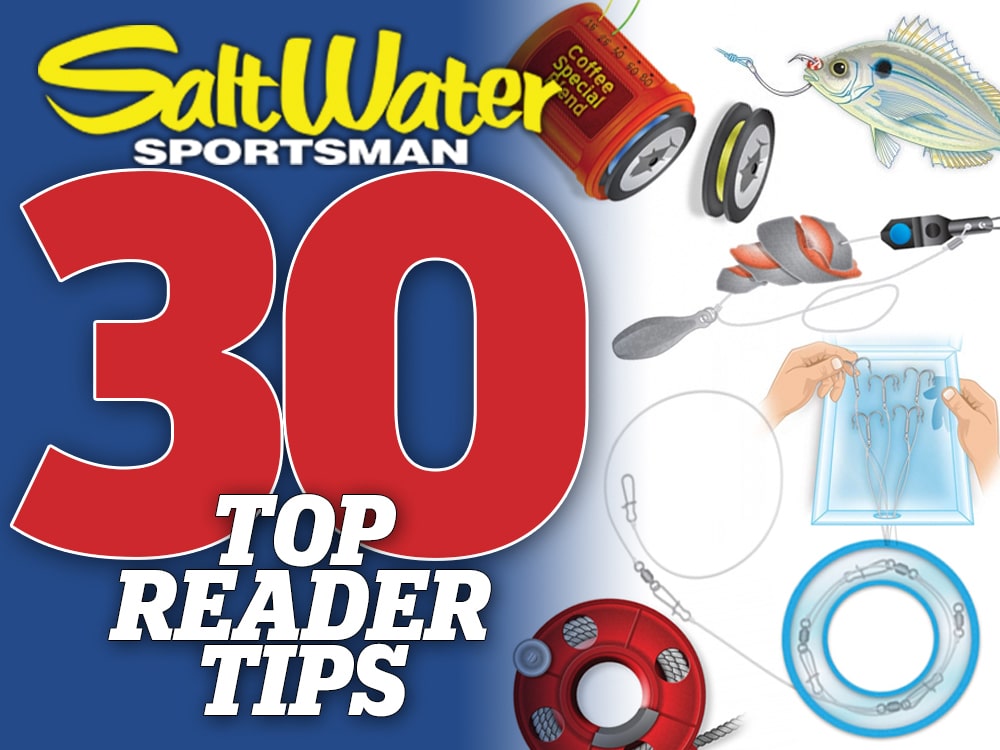
Discovery and innovation go hand in hand with successful fishing, and anglers constantly look for new and better ways to do things. And that’s something Salt Water Sportsman readers have always been good at—as attested by the continuing popularity of one of our most popular departments, “Sportsman’s Workbench.”
Here’s a collection of 30 of the best tips readers have shared over the past five years.
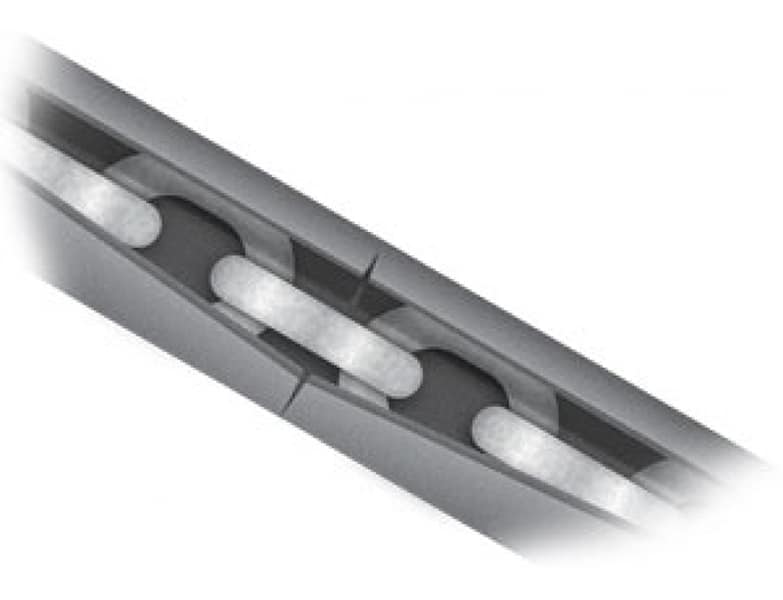
I fish primarily out of Savannah, Georgia. At certain times of the year, currents can get pretty strong, which requires heavier anchors, as well as anchor chains. Through the years, I have tried galvanized and painted anchor chains, but nothing seems to stop the rust or protect the boat when you are pulling anchor. The solution isn’t anything fancy, however, and it’s quite effective. I cut a tube used for a bicycle tire so I have one long, continuous tube instead of a circle, then simply slide it over the chain all the way down to the top of the anchor shaft. Now your boat will remain rust- and nick-free when pulling your anchor in.
From Ashley Smith, Savannah, Georgia
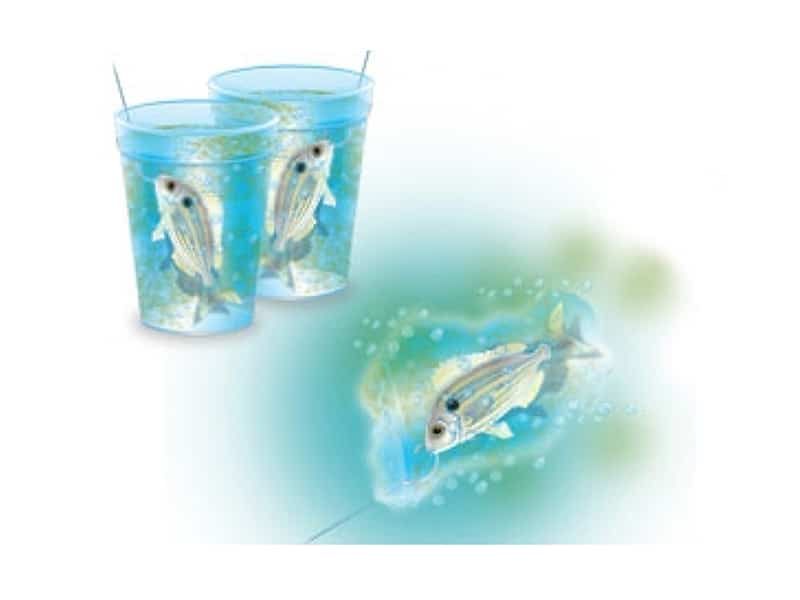
Bottomfishermen have all lost baits to stealers like pinfish and triggerfish during the drop. Here’s a frozen treat to keep the thieves away and attract big bottom dwellers. The night before I go fishing, I put pre-rigged whole baits into plastic cups with a mixture of chum and water and freeze them. Once on the water and ready to drop, I attach the rig, remove the plastic cup and send the baitsicle down. Surface fish will attack during the descent, but the hard, frozen surface protects the bait. After the bait’s descent, the buoyancy of the ice holds it off of the bottom, and the gradual melting causes a chum release, letting the big ones know there’s a meal in the area.
From James Victory, Gautier, Mississippi
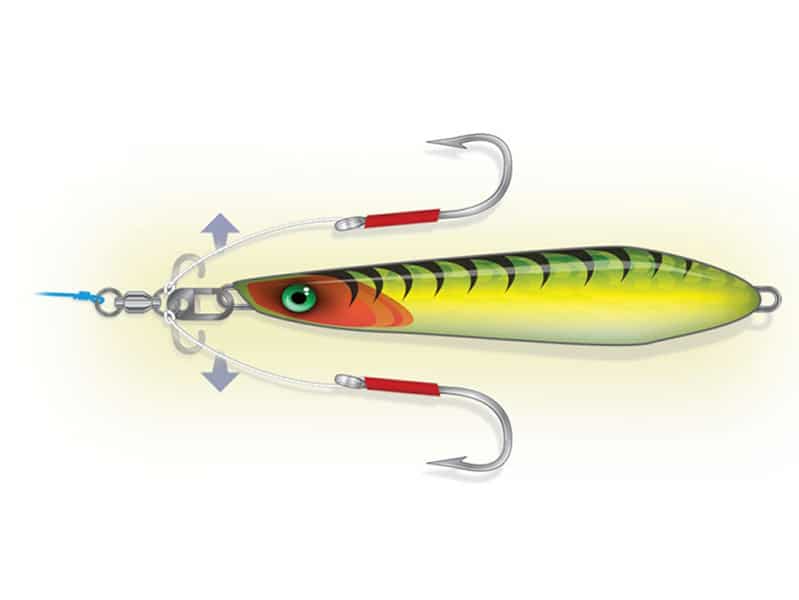
Here is a useful system for speed jigs that allows quick changes of jig size or color without cutting the jig off. Use a Momoi Escape Proof snap as the point of attachment for the assist hooks and the jig. Secure the assist hooks on the ring closest to the swivel, as you normally would with any speed-jig/split-ring combination. Then place your speed jig on the Escape Proof snap. You can now easily change out jig weights or colors and also store your jig bodies without the hooks attached, for minimal tangles.
From Adrian Gray, Fort Lauderdale, Florida
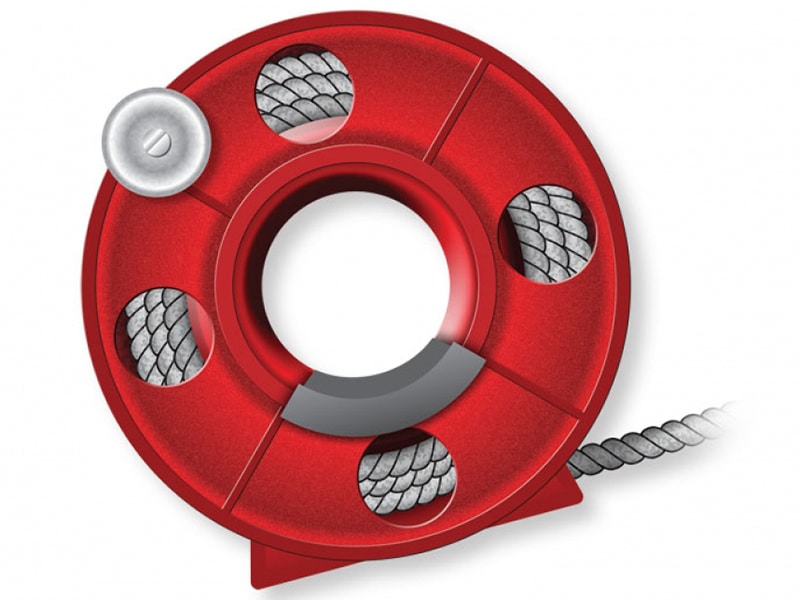
I run a flats boat, and any extra room I can make for storage is beneficial. To maximize space, I use an outdoor extension-cord reel for my anchor line. It holds 100 feet of 3⁄8-inch nylon rope on the reel, and I stow another 100 feet, which can be added if needed, under the front deck. This keeps things neat and makes anchoring and line retrieval much easier. The reel costs $8 to $10, and the only change I make is switching out the reel knob bolt to a stainless-steel one.
From Henry Booth, Apopka, Florida
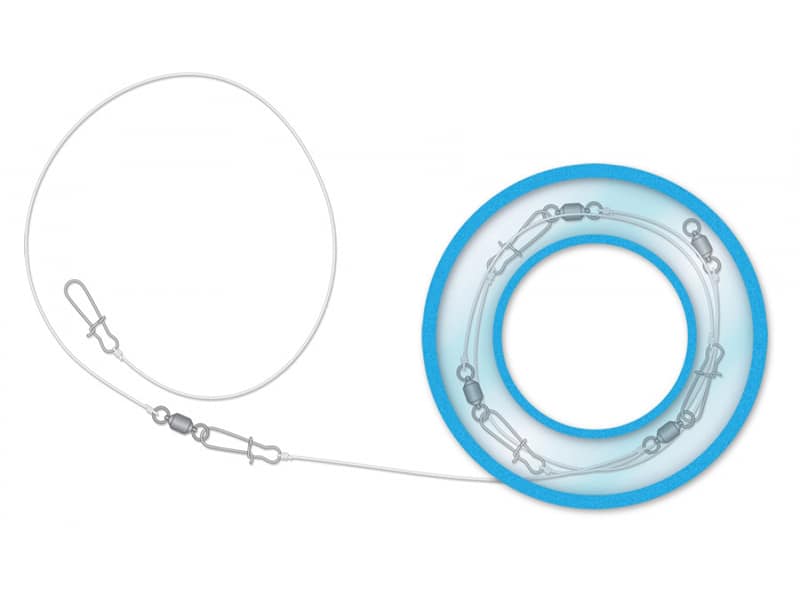
Here’s an easy way to store leaders. Cut your fluorocarbon leader into segments, tying a barrel swivel and snap to each end. Next, clip the snaps of one finished leader to the barrel swivel of the next leader, and so on, then wrap them onto a spool, securing them with a rubber band. You can pull off one leader at a time for fast and easy use, without having to worry about tangles.
From Robert Capodanno, Fairfield, Connecticut
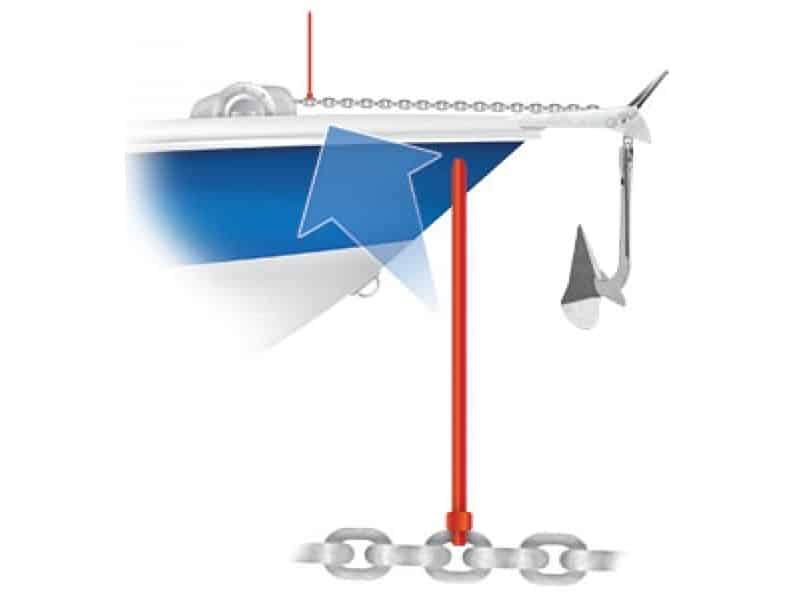
Having a windlass on your boat is truly a pleasure – and a back saver to boot! One of the first things you learn when using a windlass is the importance of knowing when the anchor is coming up and over the roller on your bow or pulpit. It’s at this point that the operator should slow the retrieve and ease the anchor up inch by inch over the roller and into its final position. To keep your anchor from coming up too fast and damaging your roller or windlass, you need to know how much chain you have retrieved and when to slow down for the anchor. A brightly colored zip tie around a link of chain is a simple fix. Leave the tag end long, and you now have an indicator flag that lets you know exactly when it’s time to slow down and creep the anchor up into the final position.
From Richard DeMarte, Long Island, New York
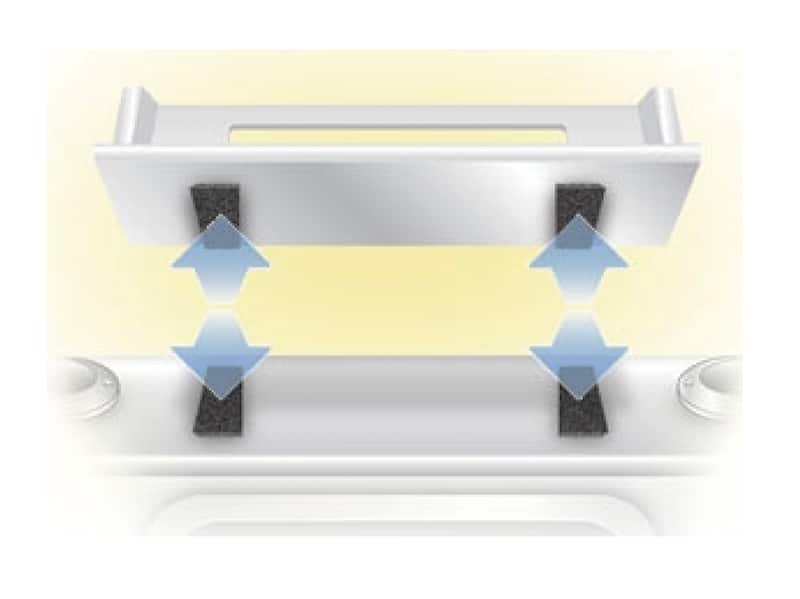
I love my boat, and I love to accessorize it with things that fit my style of fishing, but it’s rare for me to drill holes in order to do so. Recently I wanted to work a bait table in somewhere on the boat. I’ve seen rigs that are essentially homemade, but with almost all of them, holes must be drilled. I’ve also seen bait tables that fit in a rod holder, but I’d much rather put a rod in it than a bait table. To solve this dilemma, I chose a location on the gunwale and used a marine-grade adhesive to affix two soft-side strips of Velcro. Then I glued the stiff-side pieces to the bottom of my bait table. Now I have a removable bait table that I store when running. I did the same to a larger surface, and I now use that as a fish-cleaning table.
From Joe McCooey, Matunuck, Rhode Island
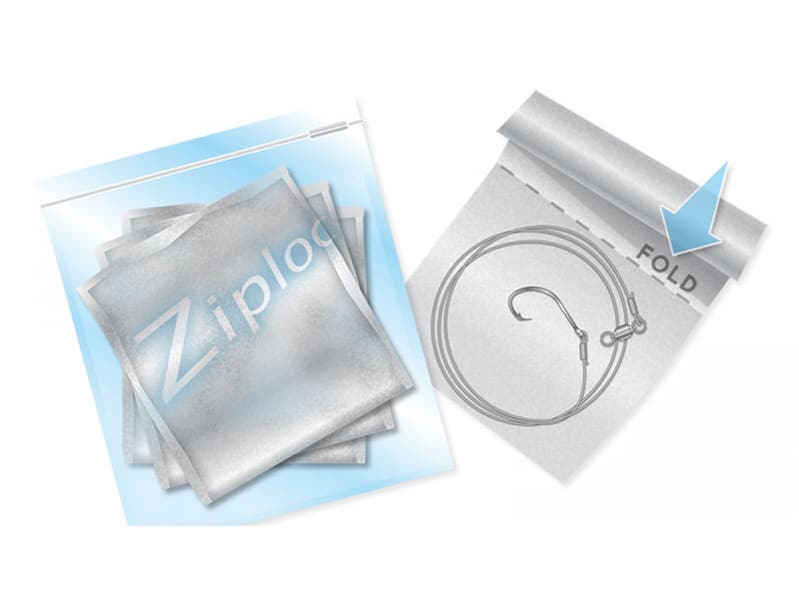
After individually flat-wrapping pre-tied rigs in heavy-duty aluminum foil, I can stack as many as a dozen tangle-free rigs in a quart-size reclosable bag. The aluminum-foil wrap keeps them tight and organized and prevents the hooks from poking holes in the plastic bags. I can fit approximately 120 rigs in a dozen reclosable bags, or 10 rigs per bag. I label the bags with a permanent marker for easy reference.
From Michael McCarthy, Gulfport, Mississippi
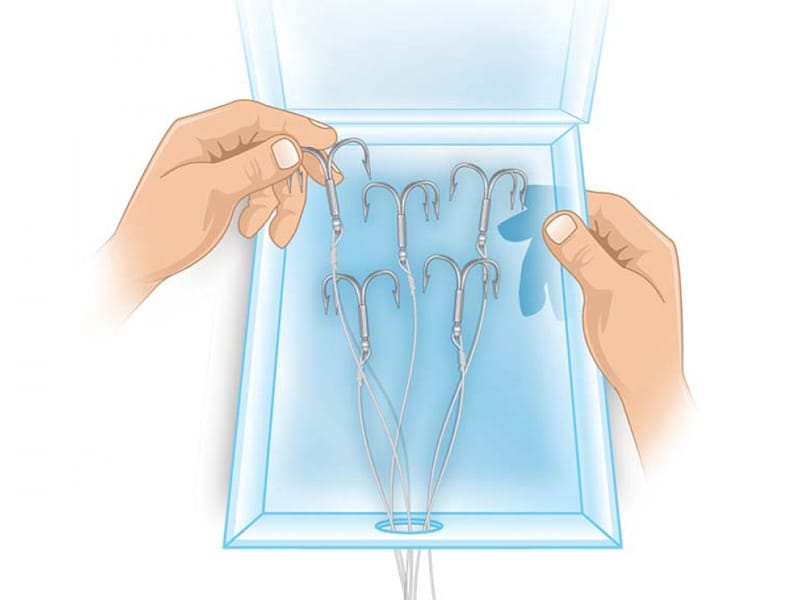
Here’s a tip for an easy-change leader system to eliminate tangled treble hooks. Drill a hole through one side, at the end, of the plastic box a 25-pack of trebles comes in. Tie your leaders to each of the hooks. Place the hooks back in the box, and pull the leaders through the hole. When you need a hook, open up the top of the box, grab a hook and simply pull it out, as the leader comes out effortlessly. No tangles, no time wasted and easy storage. It’s perfect when you are fishing for toothy predators like kingfish or bluefish and need to change rigs quickly.
From Drew Allen, Breezy Point, New York
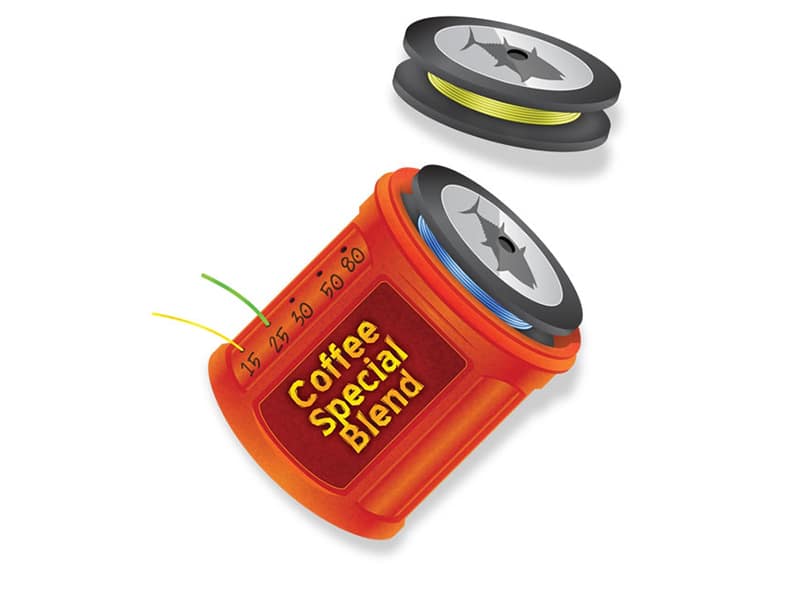
Here’s an easy way to store up to six leader spools using a leftover plastic coffee can. Load the leader spools in the can, drill out holes for the line to exit out the side, and pull the tag end of each leader through a hole. Make the holes snug, and they will grip the leader and hold it firmly, while the leader spools are free to spin inside. Label the pound-test of the line below each hole with a black permanent marker.
From Thomas Martin, Indialantic, Florida
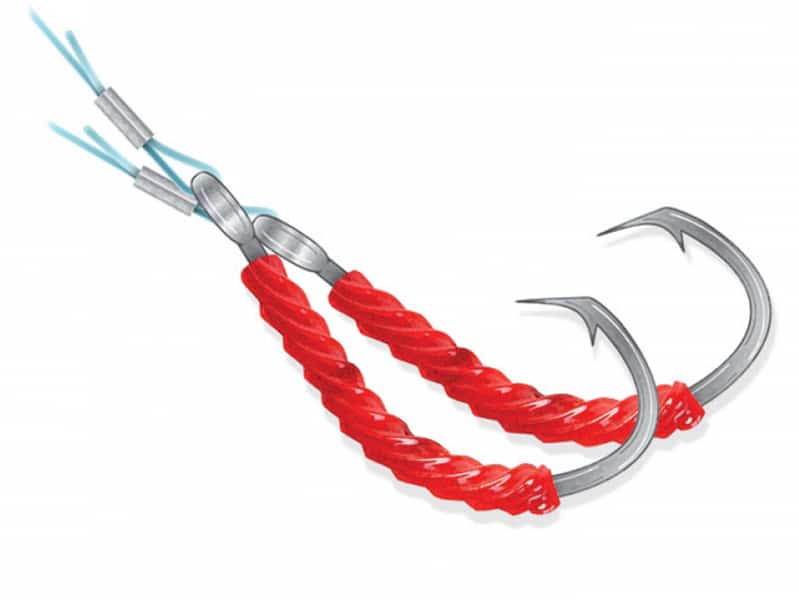
On a recent cod fishing trip, I was picking away at cod but noticed another angler bailing fish at a much better clip: The only difference was he was using a pink skirt on his high-low clam-baited rig. I didn’t have any pink skirts in my box, so I cut one of the red Twizzlers I’d brought as a snack in half and slipped my leader and hook shank through the center of it. My catch ratio instantly increased! I will never go cod fishing or any kind of bottomfishing again without a pack of Twizzlers. They make excellent, durable, cheap attractors.
From Austin Perilli, Brooklyn, New York
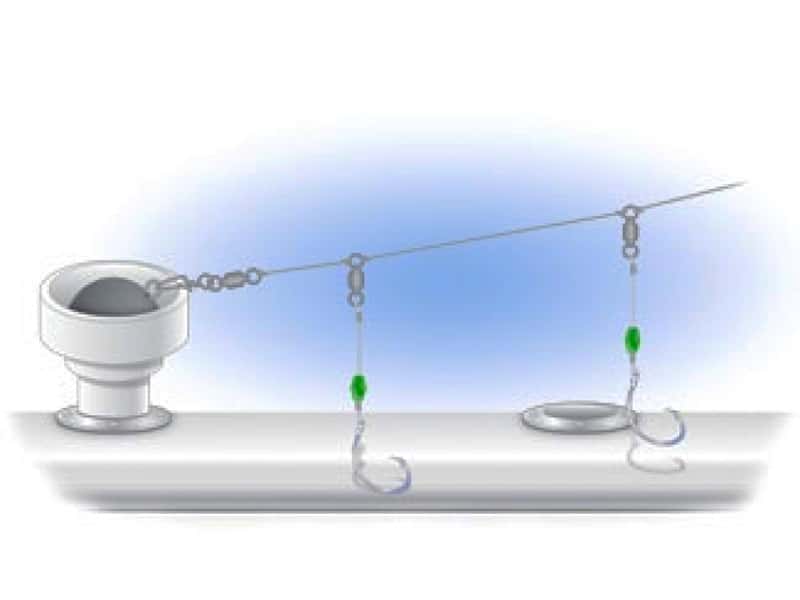
I deep-drop frequently and never can find a place to put my weight when baiting hooks or regaining a drift, so I made this holder out of PVC pipe for about $5. Slip 1 foot of 1-inch PVC into to a 1- to 112-inch female-to-male PVC adapter. Place a 112- to 312-inch double female adapter over that. That finishes the rig and is ultimately where you place your weight. When you’re ready to fish, put on your leader, put the weight in the holder, and make the line taut between the weight and the end of the rod. This system keeps the weight secured and accessible and the hooks in an easy-to-bait string.
From Jim Loffredo, Jensen Beach, Florida
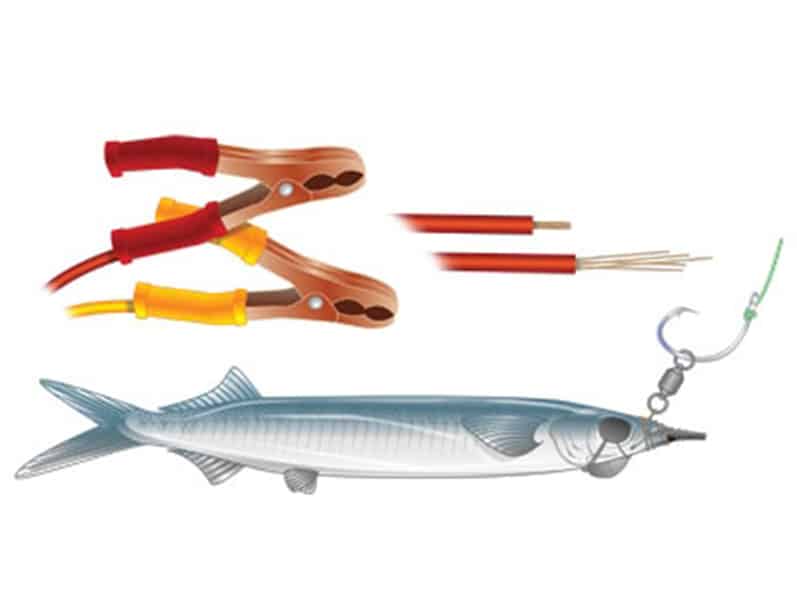
If you fish offshore and want an inexpensive way to stockpile rigging wire, this tip will certainly help you out. When it was time to replace my jumper cables, I didn’t want to just throw them away – after all, we are all trying to be green. From the faulty set of jumper cables, I removed the clamps, then split the cables apart and cut them to an appropriate length. By trimming an inch of the insulation off one end, I can use pliers to pull out individual strands of wire while keeping the rest nice, neat and secure. Now I can make the rigging wires as long as I want, plus they are stiffer and heavier gauge than most copper wire found in tackle stores.
From Capt. Bob Frevert, Jupiter, Florida
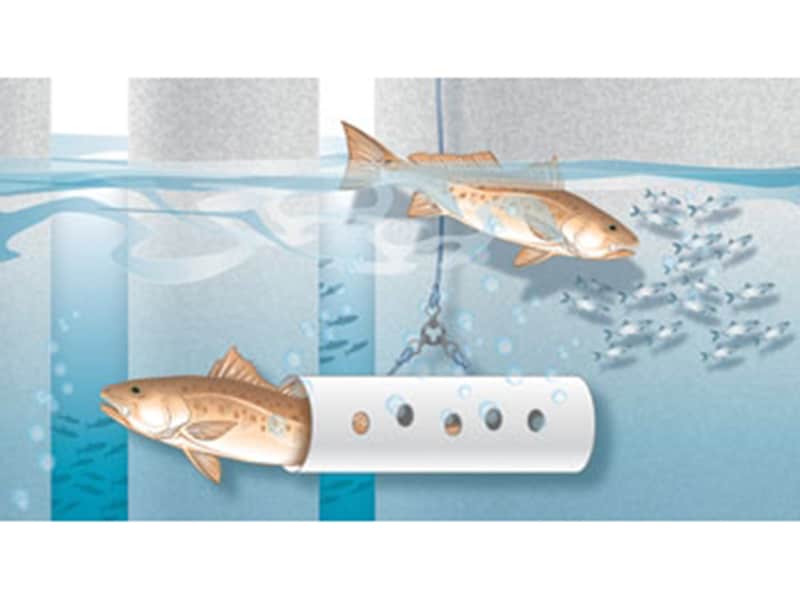
Help From Above
Most of my fishing is done from bridges and piers that are high above the water. I’m often concerned when releasing an oversize redfish or out-of-season snook that the fall from such a height might be detrimental. Here’s an easy, fish-friendly solution I came up with. I start by drilling holes along the length of a piece of 12-inch-diameter (or larger) PVC from 25 to 30 inches long. Next, I take a 3-way swivel and form a yoke using polypropylene rope. Each end is attached so the PVC fish cradle hangs level from the swivel. I then attach 30 feet or more of poly rope to the swivel to make the hand line. When I have to release a fish, I slide it into the tube and lower the cradle. When it reaches the water, the holes fill the tube with water and the fish swims away unharmed, no worse for the wear. I am sure that this would work for stripers and other species as well.
From Nick Theocharakis Jr., Tampa Bay, Florida
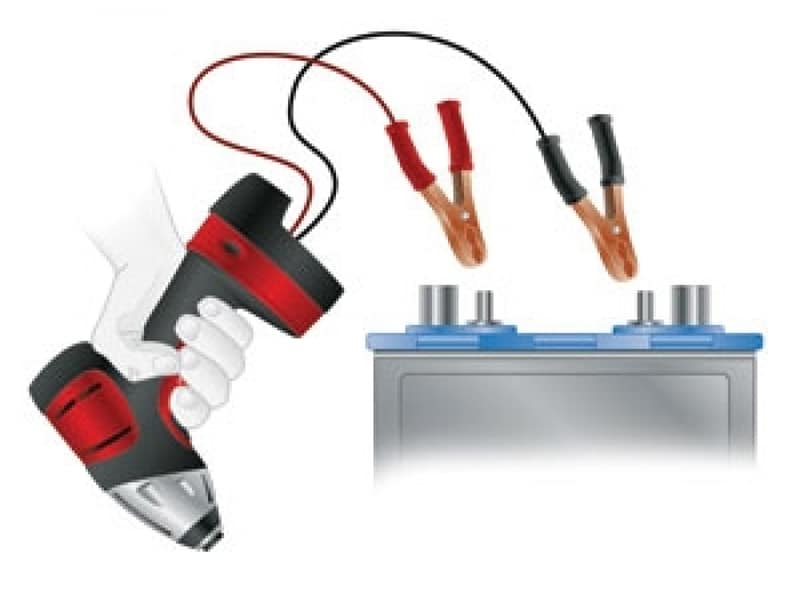
It seems like whenever I need to use my cordless drill to fix something on my boat, the battery is dead. To solve this dilemma, I took an old 12-volt drill that had seen better days and attached a 20-foot cord to it with alligator clips on the end. I now leave this drill on the boat and hook it up to the main battery, and I never run out of power.
From Robert Goracci, Milford, Delaware
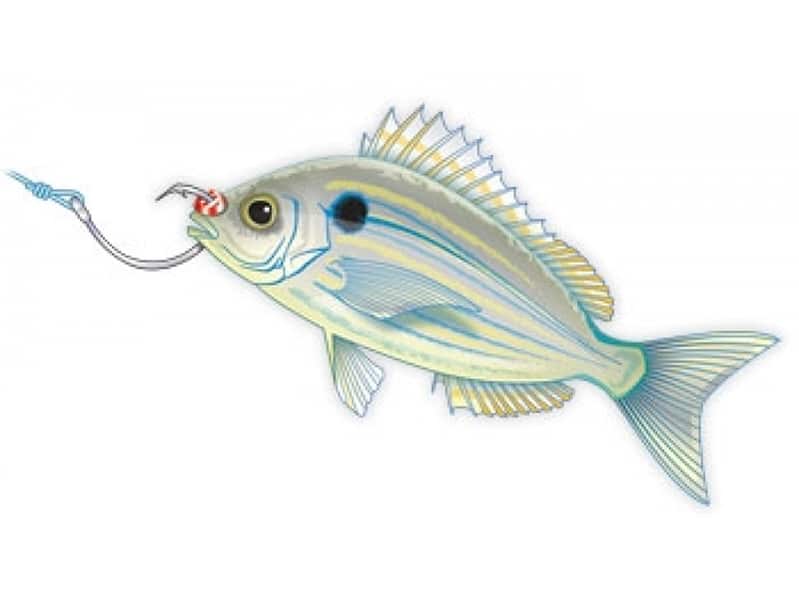
Tired of losing live baits as they wiggle their way off hooks or get short-bit by finicky fish? If you’d rather soak a sardine than a bare hook at 400 feet, try this: After you hook a live bait, poke a cheap sequin over the barb to lock on the baitfish. It keeps the bait from wriggling loose or falling off, and you can easily buy hundreds of sequins for pennies at hobby stores. Works for me!
From Barry Barrett, North Palm Springs, California
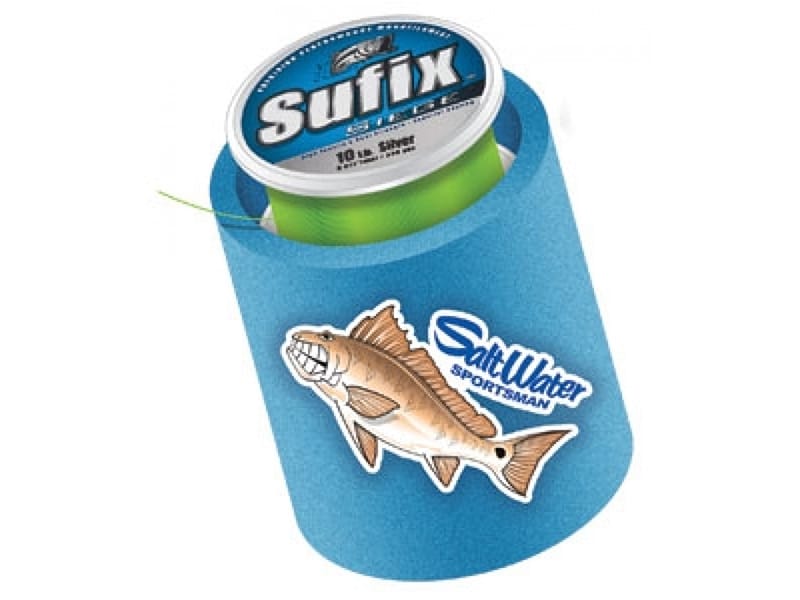
I’ve been to a lot of conventions where everyone gives away can koozies [cozies]. On a recent fishing trip, I took a few along to keep everyone’s beverage of choice cold. When we use leader on my boat, it comes off the 234-inch spools. As we pull it off, we have to secure the tag end so it doesn’t unravel. We used a rubber band or tape for that job until the day I brought too many koozies along. I looked at the two and decided to try to put the spool in the koozie, and it fit perfectly. Now we slide a spool of line into the koozie and leave the tag end out, pulling off as much as we need.
From Derik Fairchild, Pensacola, Florida
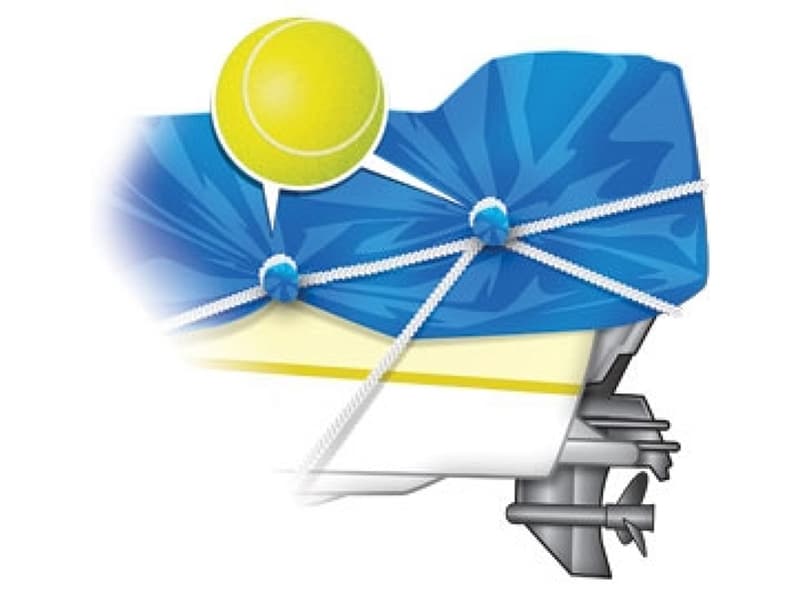
I store my boat in a yard that abuts the tidal flats of the Merrimack River, where it is exposed to winds out of the northeast. We get some really nasty weather that the grommets on my tarp cannot handle. After purchasing too many new tarps, I developed a better system. Now I simply slide a tennis ball under the tarp, give it a twist and then tie the lines around the base of the ball. The twist takes the slack out of the tarp, provides an effective tie-in point and almost eliminates flapping. I’m amazed at how simple, strong and effective this system is.
Sean King, Newburyport, Massachusetts
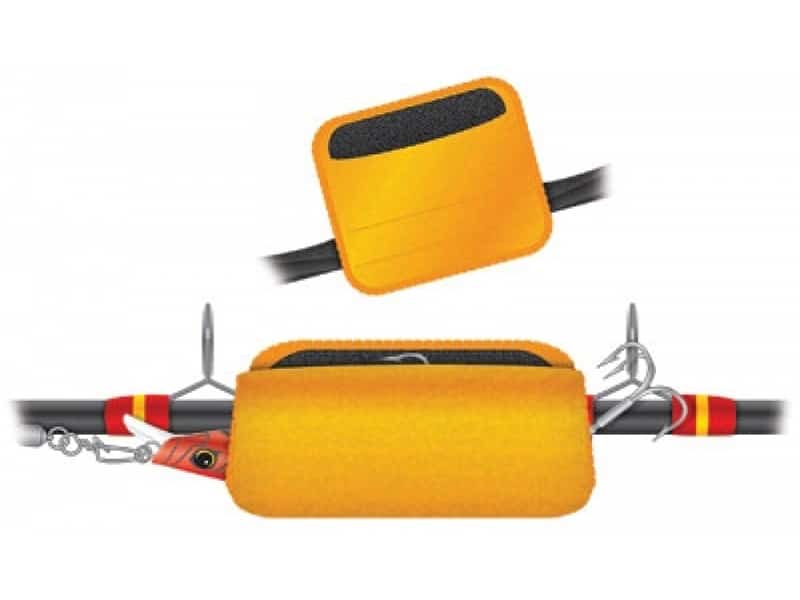
While deep jigs such as butterfly jigs are great lures for catching fish, their weight makes them difficult to keep stored on a rod when you are running from spot to spot. They often swing off the guides, which can be dangerous and can damage the rod finish.
A quick solution that many of us have lying around the house is a Velcro handle fastener from an old duffel bag, the piece that is used to wrap both handles together. It can be cut off and still leave the duffel bag in good working condition. Now, before I run from spot to spot during a day of dropping jigs, I slap one of these old fasteners around the jig and the rod to hold everything in place.
Capt. Merritt Matheson, Palm City, Florida
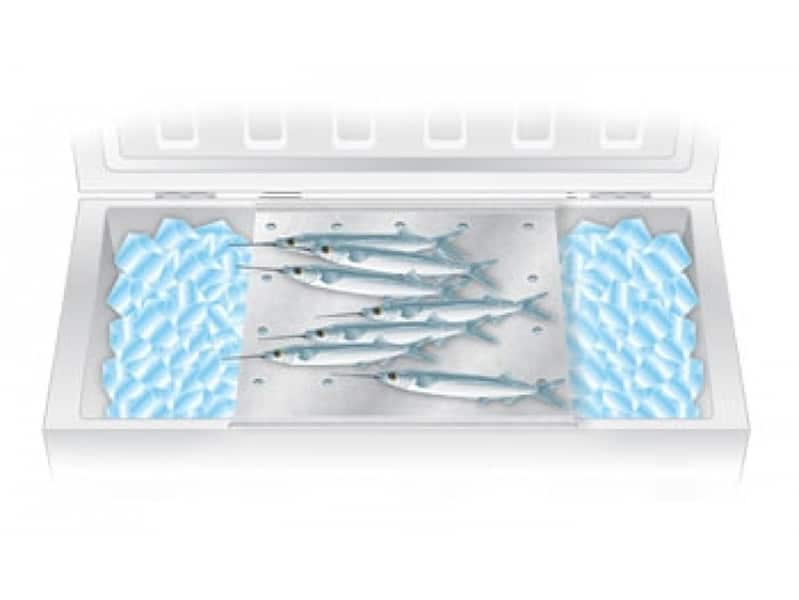
I have a tip that helps frozen bait stay firmer, more durable and intact much longer when thawed. Instead of dropping my frozen bait into a bucket of water or laying it in the hot sun to thaw (both are popular methods), I have found that thawing it slowly over a block of ice leaves it in far superior shape. I place the frozen bait in an ice chest with a block of ice the night before a fishing trip and allow it to slowly thaw through the night. The slower thawing time allows the bait to gradually return to its natural, firm, freshly-caught state. Every fisherman knows that quality bait is important in any kind of fishing, and I have noticed a significant improvement with ballyhoo, menhaden, Spanish sardines and even shrimp since eliminating the mushy, soggy bodies brought about by fast and/or wet thawing procedures.
From James Victory, Ocean Springs, Mississippi
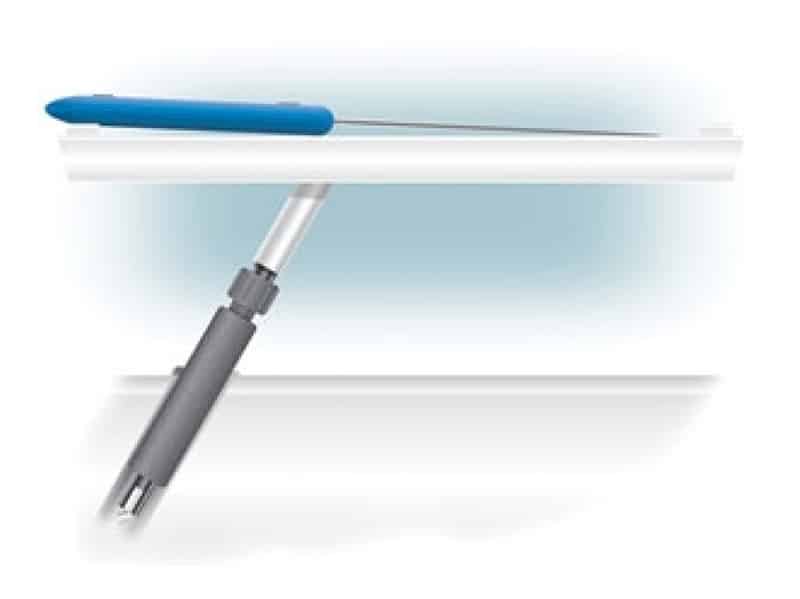
Rather than having to clean up a fish-cleaning station after a day of fishing, I clean all my fish on my boat, as I’m going to have to wash it down anyway. A cleaning station that’s the right height saves your back and helps make short work of a large catch. I have a 19-foot boat, which has relatively low gunwales. I have a cutting board that was designed to fit into a gunwale-mounted rod holder, but because of my short gunwales, I found it awkward and uncomfortable to clean fish on it. To remedy this problem, I stuck the butt piece of an old two-piece offshore spinning rod inside the shaft of my cutting board. I placed it in the rod holder, and it was nearly the perfect height for me to stand up and clean my fish. I cut it down a little bit and used epoxy to secure the board to the rod. The rod fits right in the holder, and the gimbal butt keeps it from spinning while I fillet my fish.
From Chris Nastasi, Atlantic Highlands, New Jersey

A simple modification to a D.O.A. or equivalent plastic shrimp will allow you to cast it much farther. I push the head of the shrimp back away from the eye of the hook, remove the rubber from a small rubber-core sinker and crimp the sinker around the shaft of the hook. The sinker already has a wide slot in it for ease of crimping. You can adjust the size of the weight to accommodate any fishing condition.
From George Fox, Sebastian, Florida
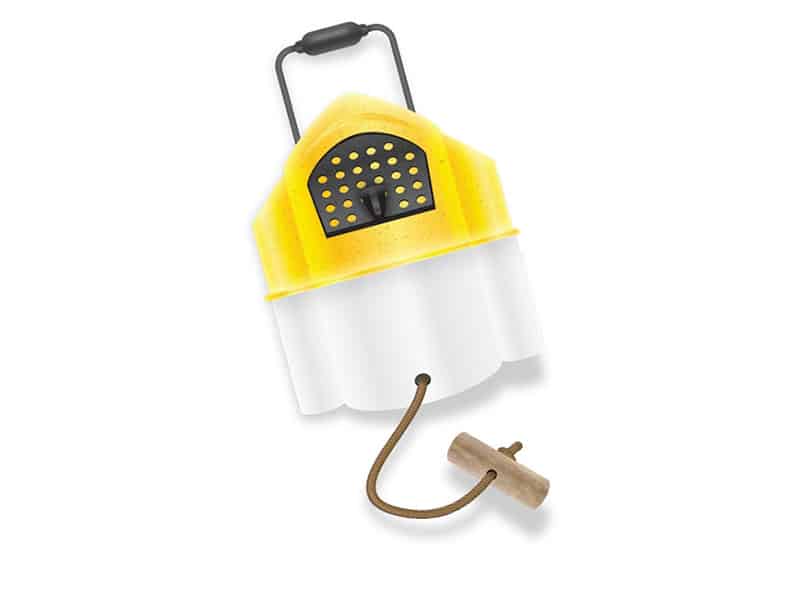
tWhen you’re retrieving a bucket from over the side to get a fresh bait, it is often difficult to avoid spilling water in the boat. Here’s a solution:
1) Drill a 3∕16-inch hole in the bottom edge of the bucket.
2) Run a short piece of 3∕16-inch rope through the hole, tie a knot on the inside of the bucket, and then seal the hole around the rope with a sealant.
3) Drill a 3∕16-inch hole in the middle of a section of mop handle or dowel, thread the rope through it, and tie a stopper knot.
Now when you pick up the bucket, grab the handle and use it to tilt the bucket, spilling enough water outside the boat to keep it from running over once the bucket comes over the gunwale.
From Roger Harrelson, Georgetown, South Carolina
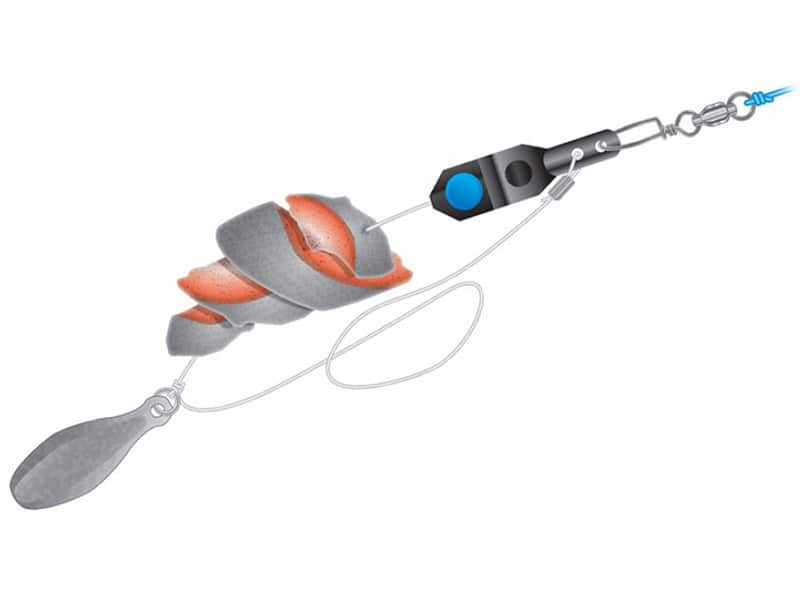
Often when you’re chunking baits, the tide and current carry the chunks far away from your baited hook. Here’s a way to lower the chunks and release them alongside your baited hook. The rig requires an outrigger clip, a snap swivel, a 12-ounce sinker, a length of at least 130-pound-test mono and a crimping sleeve.
1) Snap the release clip to the running line of a second rod and then crimp 24 inches of the heavy mono to the clip.
2) Knot in a sinker 14 inches down from the crimp. This leaves an 8-inch tag end, on which you thread cut chunks.
3) Put the end of the tag end in the clip, and lower it all to the bottom. With a sharp tug, the weight of the sinker and the snap of the rod will pull the tag end from the clip, releasing the chunks near the baited hook.
From Bobby Dufkis, Chicago, Illinois
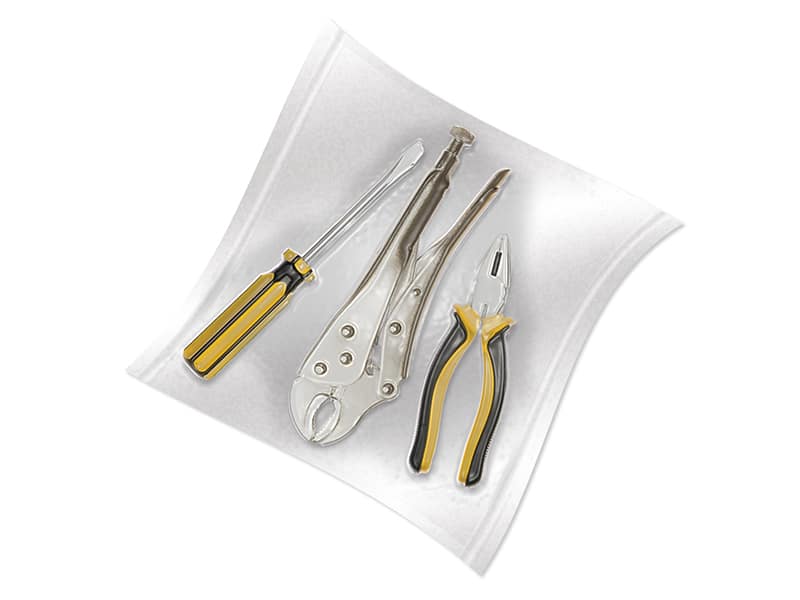
Nothing is worse than having an emergency on the water and finding your rarely used tools a rusty mess, or worse, rendered unusable by the elements. A preservation technique I’ve found effective is to lightly spray your critical items with WD-40, and then use a vacuum sealer to keep the parts and tools corrosion-free, dry and ready. This is also a good way to keep things neat and organized in your toolbox.
From James Bivens, Albemarle, North Carolina
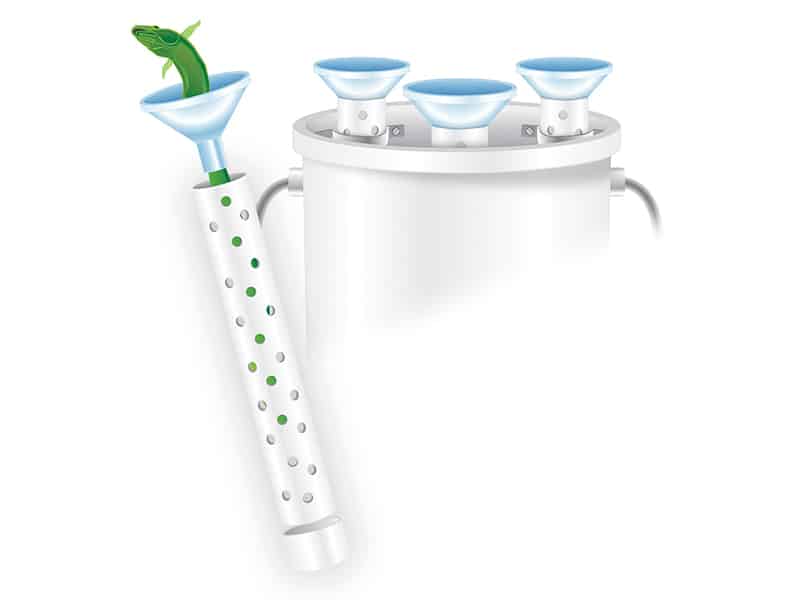
Eastern shore anglers who use live eels to fish for stripers know how the eels can tie themselves in knots when brought back aboard when you decide to relocate to a new spot. To keep unruly baits straightened out, I created live eel tubes inside a 5-gallon bucket. I drilled small holes up and down a few lengths of 1-inch PVC pipe. Then I trimmed the ends of cheap plastic funnels so they fit snugly into the tops of the pipes. I cemented a cap on the bottom of each pipe and attached the pipes to the inside of the bucket with plastic conduit straps. Simply fill the bucket with water and feed the eels into the tubes tail-first whenever you pick up to find a new fishing hole.
From Brian Taylor, York Springs, Pennsylvania
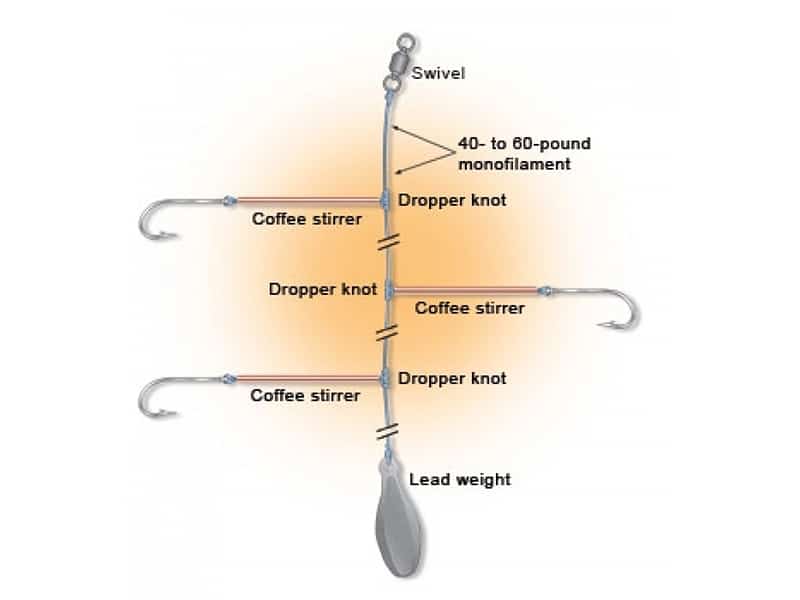
I’ve been bottomfishing for most of my life, and I love to use dropper rigs with multiple hooks. One problem I always seem to have with them is that the dropper loops tend to spin around the main line and tangle. I came up with a way of stiffening the branch lines to keep them away from the main line with the help of plastic coffee stirrers. The ones I found are about 6 or 7 inches long, and I cut them in half. When I make my dropper, I start with about 4 or 5 feet of 60-pound monofilament. I slide the straw on, put the mono through the hook of my choice and then pass the mono back through the straw. Then I finish the branch with a standard dropper knot. Repeat the process three or four times and then finish the rig with a swivel on one end and a bank sinker on the other. This setup catches plenty of red grouper and vermilion snapper and a bunch of other species.
From Tony Fernandez, West Palm Beach, Florida
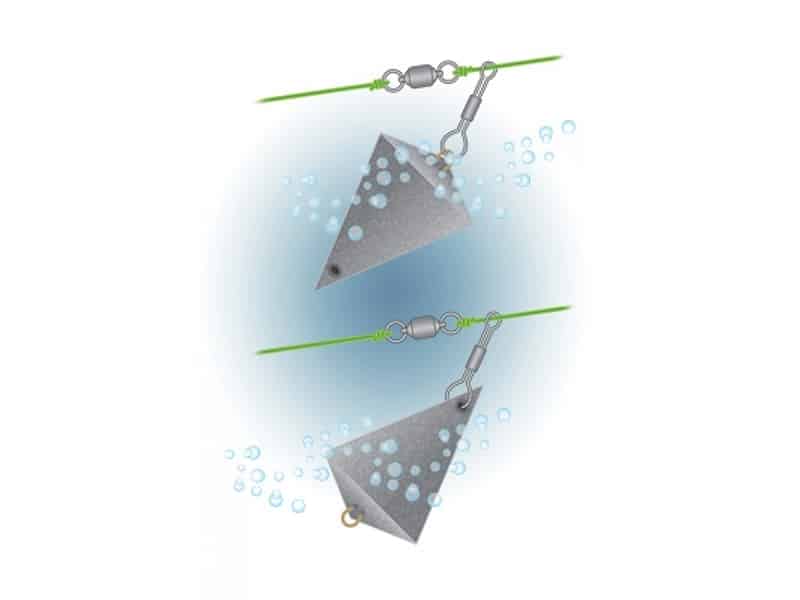
With all the gear anglers can accumulate these days, tackle bags can get heavy, causing them to be quite cumbersome. In an effort to shave off a little weight from my gear bag, I came up with a solution to minimize the amount of sinkers I carry. The method is very simple and doesn’t call for any major tools. I took a standard pyramid sinker that I use for surf-fishing and drilled a small hole in the bottom. Now I have a sinker that serves two purposes and only have to carry the one modified version. I attach the sinker by the wire loop on the flat end when fishing in the surf, and when drift-fishing, simply attach the sinker to my line through the pointy (modified) end.
From Paul Genovese, Lavallette, New Jersey
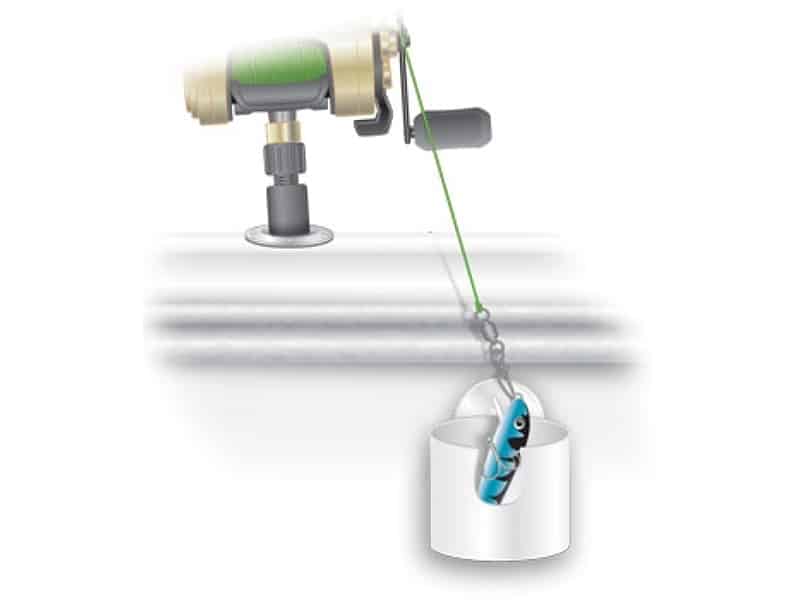
The more time your bait or jig spends in the water, the better! I am a mobile angler, meaning that I like to move from spot to spot quite often. This lets me cover a lot of water and find the fish. That being the case, I used to have to deal with my baits, lures and sharp hooks bouncing around, risking damage to my boat or, worse, me! The only other option was to de-rig before running to a new spot and then re-rig once I got to the next one, which takes away valuable fishing time. To get the best of both worlds, I started using an inexpensive cup holder that can be mounted to most surfaces with a suction cup. Instead of using it for a beverage, I stick in on the inside of my boat, close to a rod holder. When I move to a new spot, all I have to do is put my rod in the holder and my lure or the heavy part of my rig inside the cup holder. It works perfectly, allows me more fishing time and doesn’t put me in harm’s way when traveling to a new spot. Best of all, I didn’t have to use any adhesive or drill any holes in my boat.
From Andrew T. Scanlon, East Brunswick, New Jersey
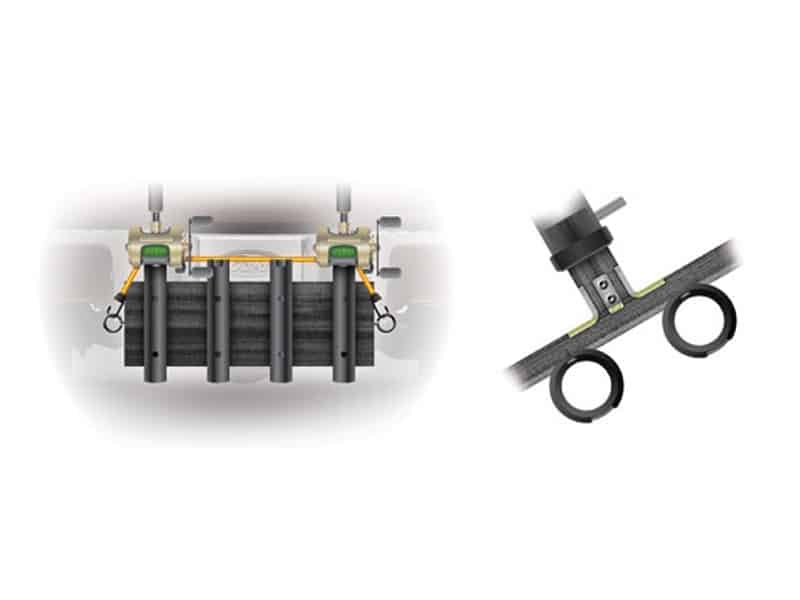
I came up with this simple rod carrier that cost less than $12 to build. You need to start with a 6-inch (approximately) 2 x 2 that will fit snugly into a 2-inch trailer-hitch receiver. In that piece, 2 inches from the end, drill a hole large enough for the receiver pin. Next, take four 18-inch pieces of PVC pipe and drill through in each piece 2 holes large enough to fit a wood screw and drill bit. Mount these PVC pipes on a 24-inch piece of 1 x 6 with the wood screws. Cut a notch in the top of each pipe so the reel seat has a place to fit. Attach the 1 x 6 to the end of the 2 x 2 using L-brackets. Put an eye bolt in each end of the 1 x 6. Slip the whole rig into your receiver, insert the pin and then drop the rods into the holder. Run a bungee cord from one eye bolt to the other across the reels to hold them in place.
From Frank Lenna, Decatur, Tennessee









